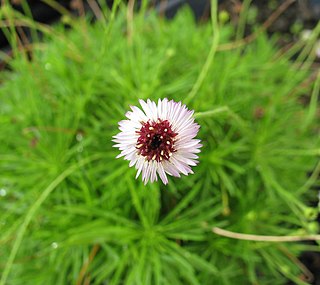
Fruit syrups or fruit molasses are concentrated fruit juices used as sweeteners.
Bulbophyllum filiforme is a species of epiphytic plant in the family Orchidaceae, found in Cameroon and Nigeria, where its natural habitat is subtropical or tropical dry, lowland evergreen forests. It was botanically described in 1895, and is currently threatened by habitat loss due to the clearing of forests for the establishment of plantations and other agricultural ventures. B. filiforme is the basionym for Vermeulen's treatment of it as Bulbophyllum resupinatum var. filiforme(Kraenzl.) J.J.Verm.

Apium prostratum, commonly known as sea celery, is a variable herb native to coastal Australia and New Zealand. The leaves are variable, with toothed leaflets, and a celery like aroma. The tiny white flowers occur in clusters.
Anomobryum julaceum, the slender silver-moss, is a species of bryophyte native to all continents except South America and Antarctica. A. julaceum is found widespread in the temperate regions of the Northern and Southern Hemispheres. Its capsules mature beginning in late fall and through the spring. It is most commonly found in wet crevices and on sandstone cliffs. Additional micro-habitats include tussock tundra with seeps and late snow melt areas and on granitic outcrops. In eastern North America it appears to be restricted to acid habitats, in the wet crevices of sandstone cliffs or other seepy niches. Overall, A. julaceum resembles species of the genus Pohlia, and its leaves are similar to those of Bryum argenteum; it can only be separated from Pohlia and Bryum using a microscope. Anomobryum julaceum can be distinguished from Bryum argenteum by its strongly julaceous, shiny leaves.

Tetramolopium filiforme is a rare species of flowering plant in the family Asteraceae known by the common name ridgetop tetramolopium. It is endemic to Hawaii, where it is known only from the Waianae Mountains on the island of Oahu. It is threatened by habitat degradation caused by feral goats and introduced species of plants. It is a federally listed endangered species of the United States.

Scaritinae is a large subfamily of beetles in the family Carabidae, containing more than 2400 species in over 140 genera. They are found worldwide.
Carenum is a genus of beetles in the family Carabidae, containing the following species:

Lepidosperma filiforme, also known as the common rapier-sedge, is a sedge that occurs in coastal regions of south-eastern Australia and New Zealand. Plants grow to between 0.3 and 1 metre high. The culms are smooth, rigid, terete and between 0.7 and 2 mm in diameter. The leaves are also terete and about 1 mm in diameter, with sheaths that are straw coloured or reddish.

Syringodium filiforme, commonly known as manatee grass, is a species of marine seagrass. It forms meadows in shallow sandy or muddy locations in the Caribbean Sea and the Gulf of Mexico, and is also found in the Bahamas and Bermuda. It occurs to a depth of about 20
Carenum imitator is a species of ground beetle in the subfamily Scaritinae. It was described by Sloane in 1897.
Carenum brisbanense is a species of ground beetle in the subfamily Scaritinae. It was described by Castelnau in 1867.
Carenum carbonarium is a species of ground beetle in the subfamily Scaritinae. It was described by Castelnau in 1867.
Carenum devastator is a species of ground beetle in the subfamily Scaritinae. It was described by Castelnau in 1867.
Carenum odewahnii is a species of ground beetle in the subfamily Scaritinae. It was described by Castelnau in 1867.
Carenum splendens is a species of ground beetle in the subfamily Scaritinae. It was described by Castelnau in 1867.
Carenum purpuratum is a species of ground beetle in the subfamily Scaritinae. It was described by Castelnau in 1867.
Carenum episcopale is a species of ground beetle in the subfamily Scaritinae. It was described by Castelnau in 1867.

Genoplesium filiforme, commonly known as the glandular midge orchid is a small terrestrial orchid endemic to the east coast of Australia. It has a single thin leaf and up to thirty greenish to purple flowers with a reddish-purple labellum. The edges of its flower parts are covered with many short glandular hairs. It is found from southern Queensland to southern New South Wales.
Labilibaculum filiforme is a psychrotolerant, neutrophilic, halotolerant and motil bacterium from the genus of Labilibaculum which has been isolated from sediments from the Baltic Sea.
Ankyloblepharon is defined as the adhesion of the edges of the upper eyelid with the lower eyelid. Ankyloblepharon must be differentiated from blepharophimosis, in which palpebral aperture is reduced and there is telecanthus, but the eyelid margins are normal. Another condition similar to ankyloblepharon is symblepharon, in which the palpebral conjunctiva is attached to the bulbar conjunctiva. Recognition of ankyloblepharon necessitates systemic examination to detect associated abnormalities such as genitourinary and cardiac abnormalities and syndactyly.






